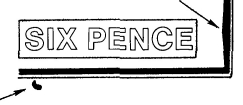
|
|
|
| Major
Varieties Of The Six Pence The six pence denomination was printed in a sheet size of 120 stamps arranged twelve columns across by ten rows down. There are several re-entries and plate flaws. As the same plate was in use beginning with the proofs of the 1862 issue through the 1884 stamp printings, these varieties may be found in all printings of the plate. I consider that the re-entries or plate flaws that should be considered "major" are those found on positions 26 (Morton Evans), position 70 (Iremonger), and position 87 (malburin). These are illustrated below. Additional less important plate flaws are reported on positions 24, 35, 40, 47, 58, 59 (Sefi No. 1), 71, 91 (Sefi No. 2) , 116, 118 and 120. |
Morton Evans Re-entry (position 26)

| This major re-entry was discovered and described by Dr. Morton Evans. It shows pronounced doubling in letters "ENCE". It occurs on position 26 from all printings of the plate. |
Iremonger Re-entry (position 70)

| This major re-entry was discovered and described by Rev. W. Iremonger. It shows right inner frame line distortion, far right hand column of engine turned background doubled, and there is a dot at lower left outside of the frame line. It occurs on position 70 from all printings of the plate. |
Malburin Flaw (position 87)

| This re-entry is called the "Malburin" because it shows a strong flaw caused by a slip of engravers burin along top frame line. It also shows traces of a re-entry at the base of letters "G" and "U". The evidence of this re-entry shows most clearly on the early impressions. It occurs on position 87 from all printings of the plate. |
Sefi re-entry No. 1 (position 59)
![]()
| This minor re-entry was discovered and described by A.J. Sefi. It shows splashes of color in the letters "S" and "P". It occurs on position 59 from all printings of the plate. |
Sefi re-entry No. 2 (position 91)
